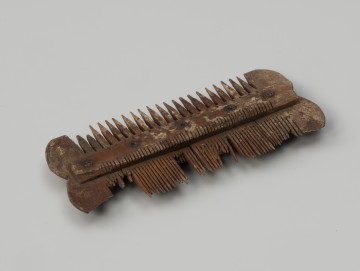
Double-sided comb, group IIB, type III
1175 — 1200
National Museum in Szczecin
Part of the collection: Middle Ages
The presented piece was found during archaeological investigations carried out between 1986 and 2001 within the boundaries of Szczecin's Podzamcze, in Trench VI, the richest in terms of the number of movable relics, established within quarter 5. The comb is in the form of a flat and narrow bone plate, with seven very long teeth, sharpened at the ends, cut into one of the shorter sides, of which only half are preserved. No special effort was made to develop its surface, leaving a rather crude appearance with visible saw marks. A small hole has been drilled in the part that forms the handle, presumably for hanging. In the past, researchers attributed them to functions related to weaving, which is why they were referred to as weaving combs. More recent studies, however, deny this function and the relics themselves are sometimes referred to as long combs, which aptly describes their shape but says nothing about the still mysterious function. Alternative interpretations suggest use for combing hair and for styling and decorating hairstyles. This is because the elongated African combs for combing, braiding and pinning up lush, curly hair are similar in form, with a tradition dating back several thousand years. However, long combs must have been in common use, as they are quite often discovered at medieval sites on the Baltic fringe. They appear suddenly, in relatively large numbers and, after a short period of occurrence in both centres associated with Slavic and Viking culture, disappear irretrievably at the turn of the early and late Middle Ages. Although their phenomenon has not yet been clearly explained, it seems likely that they may have been an example of a rather short fashion, for medieval conditions, for a specific up-do of hair – not only women's hair. Sławomir Słowiński
Author / creator
Technique
chopping, sawing, drilling
Material
bone
Origin / acquisition method
legal transfer
Creation time / dating
Creation / finding place
Owner
Muzeum Narodowe w Szczecinie
Identification number
Location / status

1175 — 1200
National Museum in Szczecin

1175 — 1200
National Museum in Szczecin

1176 — 1200
National Museum in Szczecin
DISCOVER this TOPIC
Castle Museum in Łańcut
DISCOVER this PATH
Educational path